Low-Maintenance Easy Freshwater Fish for Beginners
Low-Maintenance Easy Freshwater Fish for Beginners
Installing and maintaining an aquarium takes a lot of work. But, there are plenty of low-maintenance freshwater fish that don’t need significant attention every day, making them ideal for beginners. All pets are a commitment and shouldn’t be undertaken lightly, and an aquarium is no exception. That said, some fish are easier to keep than others, and here are some of the classics.
Neon Tetras (Paracheirodon innesi)
Fish together strong. These little guys don’t seem like much on their own, but if you have a school of them swimming around together, the effect can make for a beautiful aquarium.
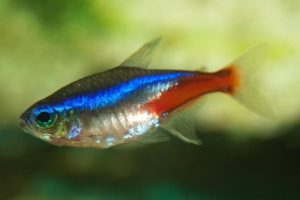
Neon Tetras grow to around one a half inches at their largest. Their small size is a bonus to new aquarium owners as they don’t make a large impact on the water quality.
Start with a minimum of three, as these social fish like to school together.
Neon Tetras can subsist on food flakes or pellets.
Zebrafish (Danio rerio)
As their name suggests, these small fish are striped white and blue/black. They’re an excellent low-maintenance fish for beginners. You can add several to your tank as they love to school together.
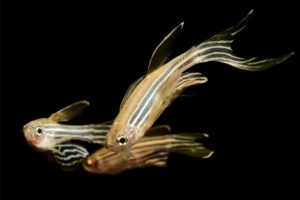
Zebrafish prefer cooler water (around 70 degrees Fahrenheit, or 21 degrees Celsius), but still consider getting a small heater maintain that temperature in the winter.
Zebrafish grow up to two inches long and can eat standard tropical fish pellets or flake food.
Betta Fish (Betta splendens)
Bettas thrive in a five-gallon tank or larger, with a filter and heater. Being tropical fish, bettas should be kept at 78 to 82 degrees Fahrenheit (26 to 28 degrees Celsius). Make sure your aquarium has a reliable thermometer. The greater the volume of water, the easier it is for your heater to keep a constant temperature.
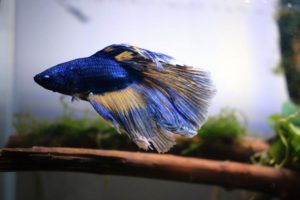
Bettas can be swept up in fast-flowing water due to their large fins. Consider the size of your filter and reduce the flow or divert it so your betta doesn’t get pushed around. Avoid adding jagged or sharp decorations to the tank to protect their fins. There are even items made specifically for fish tanks containing bettas. Betta fish reach three to four inches in length, so choose your décor accordingly.
For beginners, it’s recommended to begin with one male betta fish in his own tank. Bettas will fight with each other, hence their other name, Siamese fighting fish. Female bettas can usually get along in a large enough aquarium. Males need to be kept apart. Bettas are easy to keep in a larger aquarium, and one male betta can live alongside non-aggressive, similar-sized fish of other species.
Bettas are easy to overfeed as they have tiny stomachs. It’s best to give them pellets specifically designed for bettas. This will help them to thrive with the proper nutrition. They shouldn’t eat too much. A rule of thumb is to give them about the amount of food they will finish in three minutes, twice daily.
The Humble Goldfish (Carassius auratus)
The humble, classic, standard, basic, beautiful goldfish. They summon up images of being won at fairgrounds. They are the backbone of fish branding. Naturally, goldfish are fairly simple to keep and excellent for beginners. That said, you can’t just have a little bowl and put the goldfish in. It’s a little-known fact that goldfish can actually grow up to 24 inches in length, so make sure you have a tank large enough to accommodate. There are stories of pet owners being caught off guard at how large their golden swimmers grow.
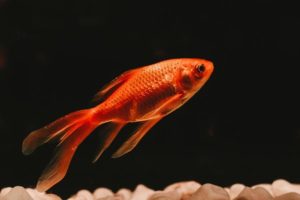
You need to keep a goldfish’s aquarium clean and free of ammonia. They’re omnivorous fish, so will eat whatever you provide. They also have a habit of eating soft plants like Anacharis and Cabomba. There are loads of goldfish varieties with similar low-maintenance care needs, so you can add a variety to your tank.
Guppies (Poecilia reticulata)
Guppies are nicknamed “Million Fish” due to their propensity to breed. Sadly, they eat their young too. If your aquarium has plenty of living space and verdant plant life, like Guppy Grass, those guppy swimmers will have places to hide and hopefully won’t all get eaten. Isn’t the animal kingdom fun?
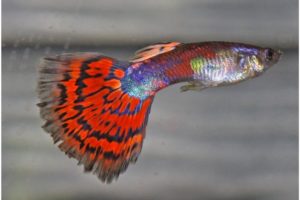
Guppies are low maintenance when it comes to living with other fish. Males will butt heads from time to time and chase females around the tank. They will generally ignore other species of fish and live peacefully among them. Guppies eat both plants and animal proteins. They’ll eat soft algae but go nuts for mosquito larvae, blood worms, and other insect larvae.
Platy (Xiphophorus maculatus)
Platies are low maintenance as they’ll eat whatever’s available in their tank. They nibble at algae, veggies, frozen food, flakes, and pellets.
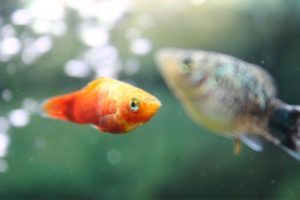
Platies make up part of a beautiful aquarium as they come in all sorts of colours. You might even get unexpected colours coming through when they breed due to a colourful lineage. You need to move the mother to a separate tank from her young if you intend to raise the fry to maturity. Sadly, livebearers are known for eating their young and even maternal instincts won’t hold them back.
Despite their appetites, platies get on well with other breeds and don’t cause any trouble in the tank, so are ideal low-maintenance fish for beginners.
Image Credits
Photo by Jaya surya Karthik on Unsplash
Photo by Nelic
Photo by Dan Olsen
Photo by Crohara
Photo by mirceax
Photo by neryxcom
Photo by wildacad


Leave a comment